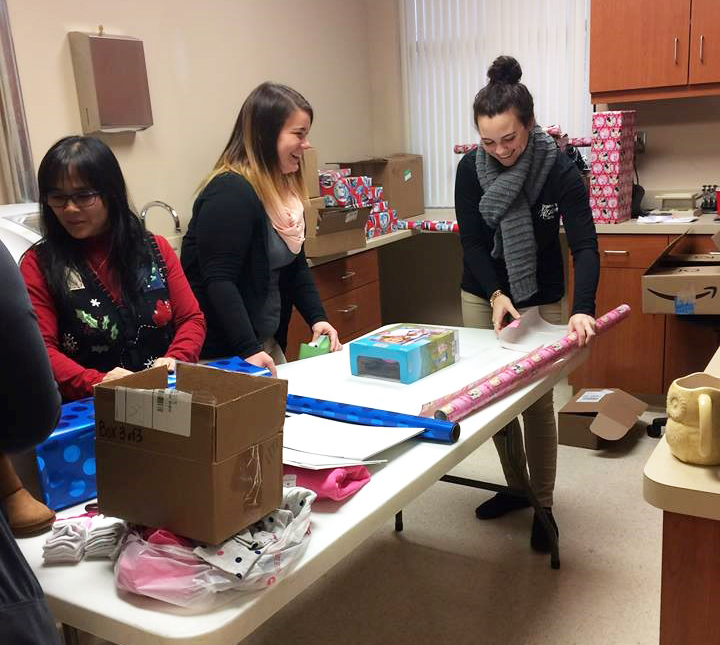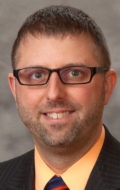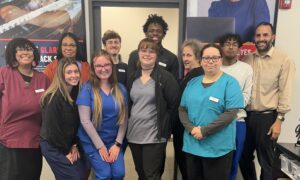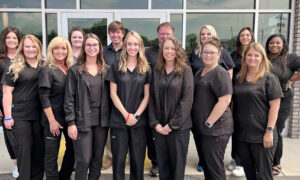
Dr. Anderson’s staff at a party to celebrate the practice reaching its goal metrics. The practice uses a dashboard metrics measuring system to track metrics, and reward the whole staff when the practice reaches its goals.
By Dave Anderson, OD
April 19, 2017
High staff efficiency enables you to see more patients per day while freeing up time to meet patient needs and ensure they have a positive experience throughout an office visit.
This is how we improved staff productivity and practice profitability by using a metrics reporting system that works in conjunction with our EHR and practice management system.
Our office employs four ODs and a support staff of 18. As we grew, we installed The Edge, a system for measuring productivity and profitability, and we continually seek ways to improve on both. We are able to track and analyze staff performance measures. We are leveraging technology to become more accurate about measuring our productivity. And our profits.
Editor’s Note: There are other practice dashboards available; The Edge is just one of those choices. For example, among the many available, are Glimpse and Crystal Reports.
Productivity: Ways to save time, eliminate tedious manual steps, and put OD and staff focus on patient care and experience.
Profitability: Ways to increase revenues, capture higher margins, or lower costs to improve net.

Dr. Anderson’s staff getting ready for a holiday party. Dr. Anderson says each staff member is equally important to helping the practice reach its profitability goals.
We provide feedback and data to staff regarding the productivity and profitability metrics tracked by The Edge at our monthly meetings. This is part of their expectation for their positions. With dashboard technology, we can see if any individual is lagging behind the others, or performing way above the others. We use this mostly as a competitive motivator, and if we have three months in a row reaching our goal numbers, we have a staff party. For instance, one month we took off a Friday afternoon to go watch a movie together after we ate lunch, another staff-wide reward was a spa day, and most recently, we shared a happy hour at a local bar with free arcade games.
Measuring Productivity
Productivity can be measured in many ways, and each area that our support staff works in is measured differently. If they are primarily a pre-tester, they are responsible for keeping the doctors on time and having the patients in the exam room within 8-10 minutes from the time they walk in the door. They are also responsible for scheduling and keeping the rooms stocked. The measure we use for them is based on their job, on time and patient care. While there is no direct correlation to increased revenue, patients who wait to see the doctor always spend less time, and invariably, less money in our optical.
Utilizing The Edge helps us to identify areas where productivity can be improved:
- Frame sales
- Lens sales (and lens features: AR, Transitions polarized, second-pair and more)
- Optical capture rate
- Staff productivity (including incentives and commissions!)
We measure our scribes against the areas of the chart that are required for MIPS and other EHR standards with help from our electronic health records, RevolutionEHR. We watch this closely as our payments and ability to participate in plans is dependent on good success here.
We measure our checkout staff against accounts receivable, our optical staff against expected percentages of sales, and finally, our contact lens staff against direct shipped and annual supply purchases. All of these areas contribute to increased profit. We treat each member of our staff as equally important to the doctors in terms of overall patient experience.
PRODUCTIVITY IMPROVEMENTS
In the short period after we started tracking AR, we went from 60 percent to nearly 85 percent. When we made this measure critical to our daily and monthly discussion, change happened, and our staff embraced it. The other thing they really wanted was to be the top sale person for the month. We currently are giving small bonuses to those that are top in the measured area. It has so far worked that one staff is best at AR, one best at second-pair sales, another at high-index lens sales, etc. It’s great to see this competition during the month, and at every meeting.
Tie Productivity to Incentives & Career Growth
Each staff member in our office has clear expectations of the minimum output that is required every day. They also know that there are always rewards both in the form of verbal praise from the doctors and managers, as well as financially, when efforts are at a maximum.
We measure several metrics every month for profitability, and this ties into productivity. If a staff member isn’t pulling their weight, bonuses and staff retreats don’t happen, so everyone has an incentive to work together and be productive, and often they overlap their duties across each area. For example, we give back to the staff 10 percent of our profit on Optomap each month that we are over 80 percent in patient acceptance of this test. Everyone pays close attention to this number, and many months we are closer to 90 percent. Where the teamwork and increased productivity shows is in both the optical and contact lens areas, as these employees often educate the patient on the value of the test after they have already seen the doctor, and convince them to have the test performed, so they can have it compared the following year.
In our contact lens area, instead of just selling contacts, our staff is mindful of the patient’s overall eyecare needs, from a back-up glasses discussion to a discussion of eye health concerns.
Assign Tracker & Use Technology to Help
We have an office manager who continually monitors all staff. She always has clear guidelines as to the expectations for each staff member. She often has to remind staff about their extra roles in the office, such as deep cleaning around the coffee maker or cleaning the frames when we have a slow down in traffic, but many times several staff can be seen already performing these extra tasks before she can provide the push.
One area that we track productivity using technology is in our optical. We are able to break down frame and lens purchases for each staff member to ensure everyone is working toward our goals. We have an 80 percent AR, less than 10 percent CR-39 and 50 percent conversion/retention rate in our optical. We periodically look at our optical staff as individuals by use of The Edge to see if anyone is falling short, or excelling, over the others. We use this both as motivation for all, and to allow us to praise those who are doing exceptional.
We post our metrics on a bulletin board in the break room, and our staff manager e-mails updates after a particularly good day, and at a minimum, once a week. We also make a habit to discuss both the total numbers, and call out the “all-stars” at staff meetings.
Change Work Flow When Necessary
One big change we incorporated recently was in the optical area. In the past, our staff always focused on the frame long before a discussion was had about the patient’s lenses. All the doctors would have a detailed handoff discussing the need for a specific progressive, material, UV needs, or AR, related to the exam and eye health needs, but this was lost as the focus quickly turned to the frame. We switched to having the lens discussion first, and saw an immediate impact, increasing our AR from 65 percent to over 80 percent the first month. We found the average frame sale didn’t change either, and the result was a higher sale for every pair of glasses as the focus became more about educating on the best lens solutions to meet the patient’s needs.
Remind Staff of Need to Maintain Quality
As you become more efficient, you want to make sure you are never sacrificing quality of patient care. We always discuss with staff how there is a balance between productivity and quality. We stress to our staff that quality work is always the most important part of their job. Exceptional patient care is what our office thrives on, and near-perfect quality is a huge part of that. One area where we see this balance as a challenge is scheduling patients. We emphasize to our staff the importance of not spending too much time with scheduling, so they are able to help with patients in the office that day, yet we also stress the importance of getting accurate demographic and insurance information. There is always a balance, and our manager pays close attention to both areas, ensuring the scheduling happens efficiently and accurately. She cross-checks patients who have been scheduled, making sure staff captured all the needed information, and then helping any staff members who didn’t gather all the needed information.
Presentations by vendor reps can sometimes remind staff of the value of the products they are selling, or the importance of the tests they are conducting. In areas that are key to productivity, we often bring in reps to be sure we have a renewed energy, as well as a knowledge refresher, and as a reminder of the importance of patient care activities. For example, we have an Optos rep visit with staff to discuss the best way to educate patients who don’t see the value of our new technology. We also have our contact lens staff meet with our vendors to discuss the best practices for year supply purchases, and our optical staff meets with our frame and lens vendors to be sure they are educated on the newest and best we offer in our office. This gives them the tools to talk more intelligently with patients, and the confidence to recommend the best, and be as productive in their role as possible.
 Dave Anderson, OD, is a partner with Miamisburg Vision Care in Miamisburg, Ohio. To contact: doca@burgvision.com
Dave Anderson, OD, is a partner with Miamisburg Vision Care in Miamisburg, Ohio. To contact: doca@burgvision.com

























